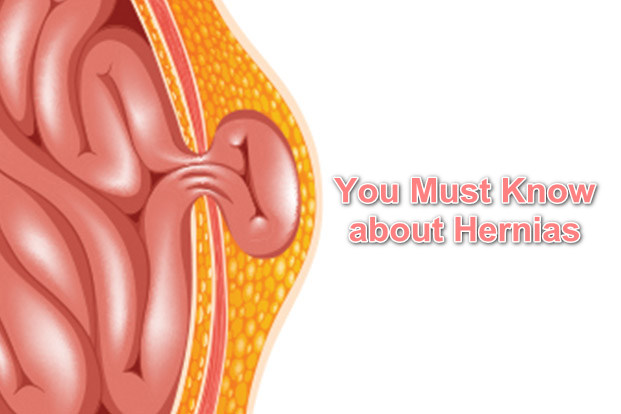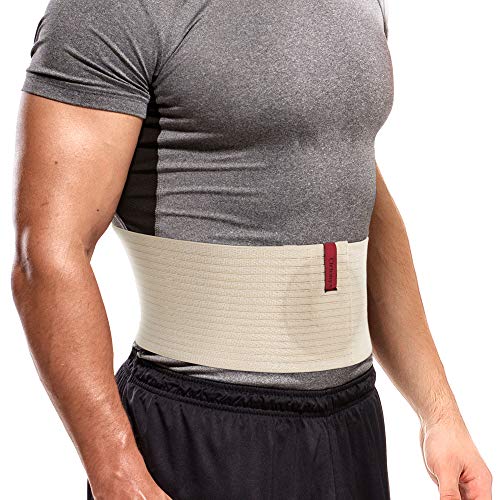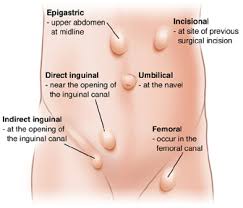
A hernia occurs when a piece of skin or organ tissue (like the intestine) bulges through the outer tissue layer that normally holds the area in.
What is a hernia?
Typically, protective layers of tissue called fascia hold organs and tissues in place. They act as a strong outer covering to keep tissue supported and in place.But sometimes the fascia can develop weak points. Instead of holding the tissue in, it allows the tissue to bulge or protrude through the weakened area. Healthcare providers call this a hernia.
Hernias don’t always require treatment, but they also don’t usually go away on their own. Sometimes you may be recommended surgery to prevent further complications from a hernia.
Symptoms:
Typically, hernias don’t hurt — you see a bulge or lump in your belly or groin. Sometimes, you only see the bulge when you laugh, cough, or strain, like when you lift a heavy object. Often, you can press it back into place. You may also notice:
- The bulge gets bigger over time.
- You have a feeling of fullness.
- Pain, pressure, or a dull ache around the bulge
- Pain when you lift something
Several different hernia types exist — and some can be extremely painful and require medical emergencies.
Keep reading to find out more about hernias, plus view images of some of the most common hernia types.
Types of hernias
Hernias involve a protruding internal organ or body part being pushed through the muscle or tissue. The most common types include:
Inguinal hernia.
Most commonly found in men, these occur when the intestine or, very rarely, the bladder extend into the groin via the inguinal canal.
Femoral hernia. Though less common, femoral hernias are often confused with inguinal hernias because they occur in a similar area for similar reasons. However, these involve a bulge appearing in the lower abdomen, groin, hip, or upper thigh.
Hiatal hernia.
These occur when part of the stomach extends into the chest through openings in the diaphragm.
Umbilical hernia. Most commonly found in infants, these occur when part of the intestine pushes into the abdomen through the belly button.
Incisional hernia. Of those who undergo an abdominal surgery, 33 percent will develop an incisional hernia. Also known as ventral hernias, these develop when the closed tissue and muscles don’t entirely re-attach, allowing internal structures to protrude through the weakened area.
Inguinal hernia
The most common symptom for an inguinal hernia is a bulge in the groin, which can appear without warning as a result of excess strain, such as:
- heavy lifting
- violent sneezing, such as from allergies
- chronic coughing, such as from smoking
- straining when urinating or having a bowel movement
- increased internal pressure in the abdomen
These bulges tend to become more visible in an upright position and may cause pain or discomfort in your groin when:
- bending over
- lifting
- coughing
- laughing
Other symptoms include:
burning or aching in the area of the bulge
heavy dragging sensation in your groin
pressure, sensitivity, or weakness in your groin
swelling and discomfort around the testicles if the protrusion descends into the scrotum
Femoral hernias
Femoral hernias, especially small- or medium-sized ones, might not present any symptoms. However, larger ones might cause pain or discomfort when standing up, lifting heavy objects, or if they appear in the upper thigh or hip.
Umbilical hernias:
For babies with umbilical hernias, the bulge may only appear when crying or coughing. These are usually painless for children, but adult umbilical hernias may cause some discomfort in the abdomen.
Hiatal hernias:
Hiatal hernias tend to be so small that there’s a chance you won’t feel them at all. However, larger ones could result in the opening in your diaphragm also becoming larger, which makes you more susceptible to other organs extending into the chest. This may feel like heartburn.
Other symptoms include:
- stomach pressure, including squeezing or twisting sensations
- chest pain
- acid reflux due to increased stomach acid retention
- difficulty breathing or swallowing
- indigestion
- Stomach acid retention may also result in stomach ulcers, which can bleed and lead to low blood counts.
Incisional hernia
Incisional hernias depend on the size of the incision. They often develop within three weeks to six months after a procedure but can occur at any time.
A bulge or protrusion at the site of the incision is the most common symptom but if too much tissue or intestine gets stuck in the weak spot, it can create severe pain when the tissue loses blood supply. This is a medical emergency and requires immediate care.
Complications
Hernias may be susceptible to several complications if left untreated, such as:
- pressure on surrounding tissues or muscles
- incarcerated or strangulated hernia
- bowel obstruction
- tissue death
An incarcerated hernia occurs if the hernia gets trapped in the abdominal wall, which can result in an obstructed bowel or strangulation.
When the hernia is strangulated, it means that blood flow to the intestine has been cut off. This is a life-threatening condition and requires immediate repair.
Symptoms for these complications include:
- fever
- sudden pain that progressively worsens
- nausea or vomiting
- a bulge that turns to a dark color, such as red or purple
- inability to pass gas or make bowel movements
Treating a hernia?
Surgery is the most likely treatment for relieving large or painful hernias. Your doctor may also recommend surgery as a preventive measure, to ensure there are no complications later on. Surgical options range from minimally invasive surgery to open surgery.
Open surgery
Open surgery involves a small incision, pushing the protruding tissue back into your body and securing the incision so the tissue doesn’t herniate again.
This often requires the surgeon to strengthen the herniated area with mesh. Once the tissue is in its rightful place, the incision is closed with stitches or stapled.

This procedure is typically performed with local anesthesia, general anesthesia, or sedation.
Rest is recommended, however, you should move around to encourage proper circulation and improve recovery. Be careful not to overexert yourself, as it may still be a few weeks until you can return to your regular levels of activity.
Depending on the site of your hernia, your surgeon will give you specific instructions on what activities you can do and when you can return to exercising and other regular activities.
Minimally invasive surgery
Minimally invasive surgery, also known as laparoscopy, involves a series of small incisions. A gas is used to inflate the affected area, which makes it easier for the surgeon to see the structures to be treated.
Another tube with a small camera will then be inserted into one of the incisions, with the others serving as entry points for the surgeon’s tools.
This procedure is typically performed with general anesthesia. Those eligible for minimally invasive surgery tend to experience less post-op discomfort, as well as less scarring.
You may also be able to return to regular levels of activity sooner than those who have open surgery.
Other options
Another option is watchful waiting, where you simply wait to see if your hernia symptoms go away or get worse.
A hernia truss or abdominal binder may also be useful. These are supportive braces designed to keep the hernia in place and prevent it from getting worse.
Abdominal/ Umbilical Hernia Belt for men & women

Conclusion:
Although many hernia types aren’t considered dangerous, they don’t get better on their own and can lead to life-threatening situations if left untreated.
Talk to your doctor if you think you’re experiencing any of the symptoms of a hernia. They can provide a personalized solution to your situation.
You should seek immediate medical attention if you’re experiencing any of the symptoms of a strangulated or incarcerated hernia, such as very painful bulge and if the bulge is red or purple.
Or
Contact us on query@gtsmeditour.com if you are experiancing any of the symptoms & get a complementary second opinion from our multi specialty hospital healthcare professional at the earliest.


Post a comment